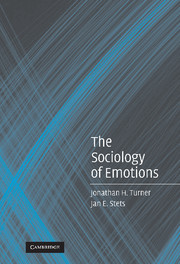Book contents
- Frontmatter
- Contents
- Tables and Figures
- Acknowledgment
- Foreword by Lynn Smith-Lovin
- 1 Conceptualizing Emotions Sociologically
- 2 Dramaturgical and Cultural Theorizing on Emotions
- 3 Ritual Theorizing on Emotions
- 4 Symbolic Interactionist Theorizing on Emotions
- 5 Symbolic Interactionist Theorizing on Emotions with Psychoanalytic Elements
- 6 Exchange Theorizing on Emotions
- 7 Structural Theorizing on Emotions
- 8 Evolutionary Theorizing on Emotions
- 9 Prospects for the Sociology of Emotions
- References
- Index
3 - Ritual Theorizing on Emotions
Published online by Cambridge University Press: 05 June 2012
- Frontmatter
- Contents
- Tables and Figures
- Acknowledgment
- Foreword by Lynn Smith-Lovin
- 1 Conceptualizing Emotions Sociologically
- 2 Dramaturgical and Cultural Theorizing on Emotions
- 3 Ritual Theorizing on Emotions
- 4 Symbolic Interactionist Theorizing on Emotions
- 5 Symbolic Interactionist Theorizing on Emotions with Psychoanalytic Elements
- 6 Exchange Theorizing on Emotions
- 7 Structural Theorizing on Emotions
- 8 Evolutionary Theorizing on Emotions
- 9 Prospects for the Sociology of Emotions
- References
- Index
Summary
In Erving Goffman's analysis of the encounter, rituals are seen as only one element revolving around stereotypical sequences of talk and other gestures that sustain the smooth flow of the interaction. Goffman's great insight was the recognition that rituals penetrate and punctuate just about every aspect of face-to-face interaction. Rituals open and close the encounter. They keep the interaction on track and on topic. They help focus individuals' attention. They key and re-key the frame. They arouse emotions if directed at a totem marking group membership, and they repair breaches. Thus, for Goffman, encounters cannot be opened, closed, and sustained without the constant flow of ritual sequences of talk and body gesturing. Formal rituals and ceremonies, such as those practiced in collective worship in church or in a graduation ceremony, are only a special case of a much more pervasive phenomenon: interaction ritual. Every interaction at each moment, from its beginning to its end, and even thereafter in people's retrospective and introspective thoughts about an interaction, involve ritual dynamics that influence the flow of emotions.
These insights came to Goffman from the work of Émile Durkheim (1912/1965) coupled with his ethnographic observations of people in face-to-face interaction. Interaction ritual theory as developed by Randall Collins (Collins, 1975, 2004) over the last 30 years takes the basic insights of Goffman and Durkheim, but transforms them into a somewhat different view of rituals.
- Type
- Chapter
- Information
- The Sociology of Emotions , pp. 69 - 99Publisher: Cambridge University PressPrint publication year: 2005
- 1
- Cited by

